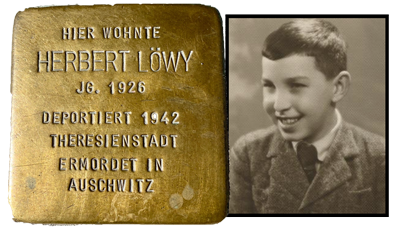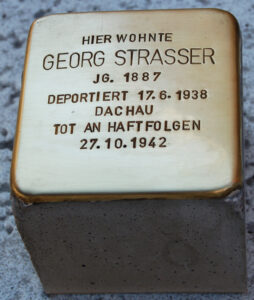Georg STRASSER was born in Nussdorf am Haunsberg, about 20Km north of Salzburg, on March 5, 1887. He was a married Catholic carpenter with five children.
After being severely injured in the First World War he was unable to continue working as a carpenter.
As a war invalid he was allowed to operate a tobacco shop in St. Pankraz am Haunsberg, about 20 km north of Salzburg. During the Austrian dictatorship from 1933-1938 he was active in the local branches of the dictatorship’s »Fatherland Front« and its paramilitary wing, the »Heimwehr« [home guard]. There he participated in the persecution of members of the Austrian Nazi party (after its failed attempt to seize power and the murder of Chancellor Dollfuss in 1934).
Because of that he was targeted for revenge when the Nazis took power in Austria in March 1938. Georg STRASSER was arrested as soon as the Nazis seized power and he was sent to the Dachau concentration camp. He was severely abused and was kept in the Dachau concentration camp until August 31, 1938 when he was released while severely ill.
It would appear that under the circumstances the Strasser family saw no future in their home village, so they moved to the city of Salzburg in September 1939 and bought a house in the Itzling neighborhood.1 But Itzling turned out to be an unsafe choice because the Nazi local district leader in Itzling, Johann Hofer, actively harassed former functionaries of the Austrian dictatorship.2
In any case Georg STRASSER was hospitalized periodically and on October 27, 1942 he died from the consequences of his concentration camp treatment and abuse. He was 55 years old.
After Austria’s liberation Georg STRASSER was recognized as a »victim in the struggle for a free and democratic Austria« [even though he had been a functionary of a brutal dictatorship and was never an advocate for democracy]. That made his widow Maria eligible for victim’s compensation. She died in Salzburg at age 73.
1 Blasius SKERL, who was killed while incarcerated in the Neuengamme concentration camp as a political prisoner lived in the house at 6 Franz-Schubert-Straße while it was owned by Georg STRASSER.
2 We know now that Rudolf BEER, a shoemaker who lived in Itzling, was arrested by the Gestapo at the instigation of the local Nazi leader Johann Hofer and was sent to the Mauthausen concentration camp where he was murdered. Denunciations led to the deportation of several Itzling residents to various concentration camps. Frau Elise Kaindl, for example, survived her incarceration in the Ravensbrück concentration camp and returned to Salzburg to find that her apartment had been cleared out at the instructions of local district leader Hofer—as recorded in a police report of her complaint.
After Salzburg’s liberation Johann Hofer was interned in the American prison camp Marcus W. Orr (»Glasenbach«) for Nazi party leaders and SS men. In December 1948 he was sentenced to 10 years in prison for violations of the Austrian war criminals act. But he was pardoned early in the 1950s and was them employed by the Salzburg electric company. He died in Salzburg in 1979.
Sources
- Salzburg city and state archives
- Dachau Concentration Camp Memorial
Translation: Stan Nadel
Stumbling Stone
Laid 14.11.2016 at Salzburg, Franz-Schubert-Straße 6


